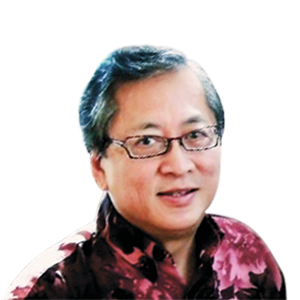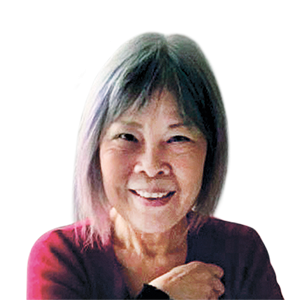A Class of its Own
April 18, 2022
IN BRIEF | 15 min read
- United through shared memories and passions, the Class of ’72 — and their close long-time friends — continues to give back to the NUS community, 50 years since their graduation.

THE GOLDEN GANG Fifty years is a long time to stay together: long enough to see one another go through trials, tears and triumphs. But for members of the Class of ’72 — an extraordinary cohort straddling four to five years (to include those who graduated a few years before and after), and first brought together on the Bukit Timah campus — the camaraderie only grows stronger with time.

Associate Professor Victor Roger Savage (Arts and Social Sciences – Geography ’72)
Visiting Senior Fellow, S. Rajaratnam School of International Studies; former Director, NUS Office of Alumni Relations (2013-2016)

Dr Loh Hong Sai (Dentistry ’72)
Former Dean, Faculty of Dentistry

Mr Roy Higgs (Science ’72)
CEO, NUS Society

Ms Juliana Patricia Lim (Arts and Social Sciences – Sociology, ’73)
Former Director of Community Affairs, Singapore Pools; Art Advocate
WHAT ARE YOUR FONDEST MEMORIES OF YOUR DAYS AT THE BUKIT TIMAH CAMPUS, AND WHAT DO YOU THINK BONDED THE MEMBERS OF DIFFERENT SCHOOLS TO BECOME ONE UNITED COHORT?
Juliana Patricia Lim: For me, the memories largely centred around music. By the time I joined NUS, there was already a very established tradition of a weekly folk song session held in one of the lecture theatres, when our batchmates Archie Ong and Andrew Liew would pick up a guitar, and all of us would join in singing folk songs like the melodious ‘Blowin’ in the Wind’ and ‘If I Had A Hammer’ that were made popular by Joan Baez and Bob Dylan. This was the era of the Vietnam War and these were American protest songs, but for us they were just nice songs of the time. We first bonded over music, and never stopped singing since — well, except during the pandemic.
Roy Higgs: You can say that the whole thing started off with friendship and links that we established on the Bukit Timah campus. While Hong Sai, as a Dentistry student, would have been at the Sepoy Lines, the Architecture school was at Lady Hill, and Engineering where Singapore Polytechnic was, at Shenton Way, the Bukit Timah campus was the central core of multiple faculties, and where students would go to for cross-faculty classes. It was also where Eusoff College, Raffles Hall and the Dunearn Road Hostels were located, so while it was a small campus, it was a gathering ground for students across faculties.
The central meeting places were where the food and drinks were. We had a few canteens: one behind the academic staff canteen; one at Union House, which was a focal meeting point; and another at the Guild House at Dalvey Road. At the former Guild House, we, the students, might go for lunch and end up being kindly treated to drinks by the members there. I still remember one of the past presidents buying us beer and lunch. That was the culture then: anybody could go in and be welcomed. And these friendships then grew into professional ties as we went out into the workforce.
Loh Hong Sai: Dentistry students did our first year at Bukit Timah campus, before we joined our seniors at the Sepoy Lines campus in Singapore General Hospital. Even when we were at the Sepoy Lines, some of us would return to Bukit Timah campus occasionally to visit classmates still staying at Raffles Hall, listen to rallies and feel the nostalgic atmosphere again. Bukit Timah campus was where there were carnivals and festivals, and a more holistic campus life. The students then were politically sensitive and activated, and there would be many speeches made. Whenever we had time, we at the Sepoy Lines would say: “Let’s go to Bukit Timah, have a beer and listen to the students there!”
There were good memories — such as studying in the Law Library, which was cool, spacious and where the pretty girls were. There were also frightening episodes: freshmen would have to wear a green tie during Orientation Week and we were constantly picked on by the Arts students. There was a popular senior who was a king ragger and I was caught by him at Newton Circus, where I was hoping to have a quiet lunch by myself. He bought me lunch, but I had to eat it sitting on the floor, being fed by two girls who were with him! Subsequently I lost a day of dental class because I had to take lecture notes for him. I guess this is the humility you need to have to become a doctor! (Laughs) But it was all in good fun, and he would look out for me later on, too. The academic side of our dentistry course was very tough but it is the friendship that sticks in our minds. Our generation largely came from humble beginnings, and we worked our way up — our mentality and the way we bonded with our peers were very different from students today. We also had a lot of Malaysians within our cohort, and they had very strong bonds, looking after one another, being away from home. They also extended their friendship to us and to this day, some of my best friends are the Malaysians I met at NUS.
Victor Roger Savage: Bukit Timah was the citadel of the spirit of the Class of ’72. Those from the Science, Law and Arts schools formed the central core of the Student Union, but the halls of residence — Raffles, Eusoff and Dunearn — were where you would find the true cross-faculty bonds. Sixty per cent of the residents at Raffles Hall were Malaysians, and that was — as Hong Sai said — very important. But it was also due to the spirit of the generation. The post-war generation was highly creative. If you just look at the pop scene in Britain and America, we had bands such as The Rolling Stones, The Beach Boys, The Beatles... we were part of this generation. Among our cohort, you would find a lot of interesting and creative people: good writers, cartoonists and photographers.
There were pranks and anti-war demonstrations which bonded us. We were also brought together by studying late into the night and going to the sarabat stall at 3am. There was also ragging, which wasn’t condoned by the University, but it bonded seniors and freshies — and many a senior-freshette pairing would go on to get married! Orientation was also a time when we organised many amazing things. I was involved in putting together big concerts at the National Theatre, featuring artistes from all the nightclubs in town, from Filipino to American bands. We even had a revolving stage which allowed the seamless changing of sets. While the freshmen were given tickets to the concerts, the rest were sold to the public, with the proceeds going to charity.
Our generation largely came from humble beginnings, and we worked our way up — our mentality and the way we bonded with our peers were very different from students today. — Dr Loh Hong Sai
WHAT ARE SOME OF THE BIGGEST ACHIEVEMENTS OF THE CLASS OF '72?
Victor: We certainly raised a lot of money for charity. On Rag and Flag day there would be a float competition, and the Arts students put up the worst floats, with nothing but us on the lorry! (Laughs) I also remember a car rally. Raising money for the underprivileged was an important cause for us; there was even a work camp during which the students might build a road or do something for the rural community. It wasn’t just fun and games, but something close to the hearts of many, for most of us came from underprivileged homes. Among the students who stayed overnight to study at the library, some did so because there was no place for them to study at home. Yet there was great generosity among the cohort: Chinese New Year always fell during the exam period, and those who went home for celebrations would always bring food back for all at the library to share. It was very touching because they shared even when they had so little, and were selfless in spreading the spirit of joy.

A LEGACY OF GENEROSITY
Juliana: For me, one of the more important initiatives created was the Class of ’72 Bursary – James Lim Teck Liang Bursary introduced in May 2011. On my own I wouldn’t have been able to fund a bursary in my father’s name, but with this sub-bursary I could do so, and dedicated it to social work. And through the bursary, I saw financially-disadvantaged students developing into confident young professionals.

WHAT ARE SOME TRADITIONS AMONG THE CLASS OF ’72?
Victor: After graduation, we started the tradition of meeting every year. It began with the Arts students, and steadily expanded. Everybody caught on to the idea of meeting, exchanging, bantering and remembering the songs we had — our shared lexicon and an important cement of our bonds.
Juliana: Somewhere along the way, this annual class gathering became Bash @ Bukit Timah Campus in May 2005. It was an emotional moment for the campus to return to NUS and I feel very proud that our humble gathering escalated into an OAR (Office of Alumni Relations) event!
Roy: Some of these events just happened spontaneously, such as our annual New Year’s lunch, which would have lots of singing and would last until 6pm. The group also grew steadily. With many of us retiring and having more time, this number has become close to100 persons.
We were less than three per cent of the total population of Singapore, but we never saw ourselves as elites. We simply took whatever cards we had based on our own circumstances and made the most out of it. — Associate Professor Victor Roger Savage
APART FROM SONGS THAT YOU SHARED, ARE THERE ALSO CAMPUS LEGENDS THAT CONTINUE TO ENTHRALL?
Victor: The campus was said to be haunted, especially the tutorial room in the Oei Tiong Ham Building, which is now part of the Lee Kuan Yew School of Public Policy. Three law students by chance chose to study in the tutorial room near the final exam period and they proved without doubt the room was haunted. According to the one eyewitness who is still alive today, when they decided to take a break and looked up, they saw that all the chairs were floating in the air! All three ran out screaming, attracting the attention of everybody at the Central Library at that point. This incident is something that very few talk about, but it stays with all of us. Today, if you go to the Upper Quadrangle, you will still see a sign put up by the administration stating that the campus is supposed to be haunted and that you might see the ghosts of Japanese soldiers marching by.
Hong Sai: Among the students, there was a lot of naughtiness, but also a lot of goodness. I look at my children and grandchildren: they have a different way of looking at education, friends and life. We went through the grind and appreciated life in a different way.
Victor: Another legendary incident was when one of the students invited Rose Chan (a popular Malaysian cabaret dancer at the time) to Raffles Hall, while the Master of the Hall was away at an overseas conference.The place was packed with some 450 boys. We asked why she accepted our invitation for free and she said: “I know you guys will all become my future customers!”
SATELLITE SCHOOLS
After the split between the University of Singapore and the University of Malaya, classes were run from four separate campuses: Arts and Social Sciences at Bukit Timah, Architecture at Lady Hill, Engineering at Prince Edward Road, and Medicine and Dentistry at Sepoy Lines. On 29 July 1980, Parliament passed the National University of Singapore Bill, and the new university was officially inaugurated on 8 August 1980.
HOW DO YOU THINK THIS DIFFERENCE AFFECTS THE WAY UNIVERSITY STUDENTS BOND TODAY?
Juliana: We were very innocent. They have social media; they know so much more about the world than we did. I don’t remember having any ambition: I was just a drifter enjoying myself.
Victor: Tertiary students accounted for less than three per cent of the total population of Singapore, but we never saw ourselves as elites. We simply took whatever cards we had based on our own circumstances and made the most out of it. Today, with 30 per cent of the population with degrees, the competition is very different.
Hong Sai: Having taught at the University, I have seen changes in the thinking and ambition of youths over four decades. I get the feeling that the younger generation focuses more on their own welfare rather than that of others. University education is also becoming more profession-centric, with more emphasis placed on setting a student on his or her career path than developing their characters and grooming them as individuals.
HOW DO YOU THINK CAMARADERIE CAN BE FOSTERED AMONG STUDENTS TODAY?
Hong Sai: At OAR, the philosophy adopted was that the first-year students are already treated like alumni, and some were appointed as Student Ambassadors to promote bonding through activities and graduate events in which they were invited. We wanted them to feel like part of the alumni family to inculcate a sense of belonging and attachment. This is done through engaging them in activities and placing them in societies. Most faculties also have a mentorship scheme where freshmen are grouped with seniors and they continue to bond over the next few years.
Roy: I am sure friendships and links will always be there among students, but the difference between the Bukit Timah days and now is the size. We were a campus of around 14,000 at Bukit Timah. In comparison, Kent Ridge is such a big campus, and its topography — North, East, South, West, all cut off from each other — means that students would segmentise into small groups. That said, within Kent Ridge, UTown is a place that offers some semblance of the social interaction we had. There are halls, dining facilities, lecture halls, places to gather — that was how it felt to be on campus. That’s a good starting point. And if we can replicate the success at UTown to recreate something where the arts, science and medical faculties are, there is potential to allow for students to naturally gather.
Victor: Having overseas exchange students studying here also helps to give our local students a perspective of what it means to be an undergraduate. Our students are too focused on academic work, studying, and their careers. Rather than soaking up the atmosphere of learning and discourse, or even just having fun, they are more obsessed with grades. Also, many of our students feel like they don’t owe anybody anything. But in Ivy League universities, 60 to 70 per cent of each student’s tuition fees is paid for by alumni, and the students are made aware of this right at the beginning. The awareness that their alumni have been donating money to their benefit creates a kind of alumni spirit. It sets the tone for the deeply-embedded relationship between alumni and students, and also inspires the younger generation to contribute to the school and the welfare of future cohorts when they graduate. Hopefully with more NUS alumni modelling this act of giving back, our young students will also follow suit.
This article was written by Koh Yuen Lin, and first appeared in The AlumNUS (Issue 129, Apr-Jun 2022).
As part of their 50th Anniversary Celebrations, the class hopes to raise at least $250,000 for the Class of 1972 Bursary Endowed Fund through a Charity Golf on 1st July and a Nostalgic Bash@BTC on 3rd July. For more information, please contact Mr David Ho (Arts and Social Sciences ’72) at davidhomail@gmail.com.

